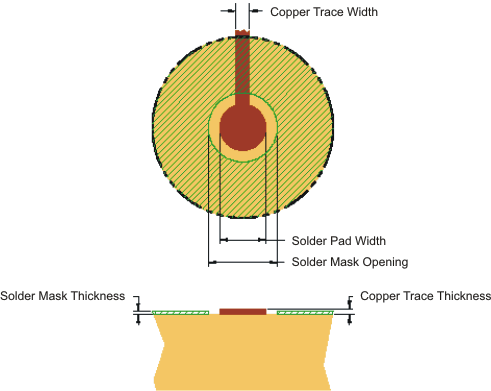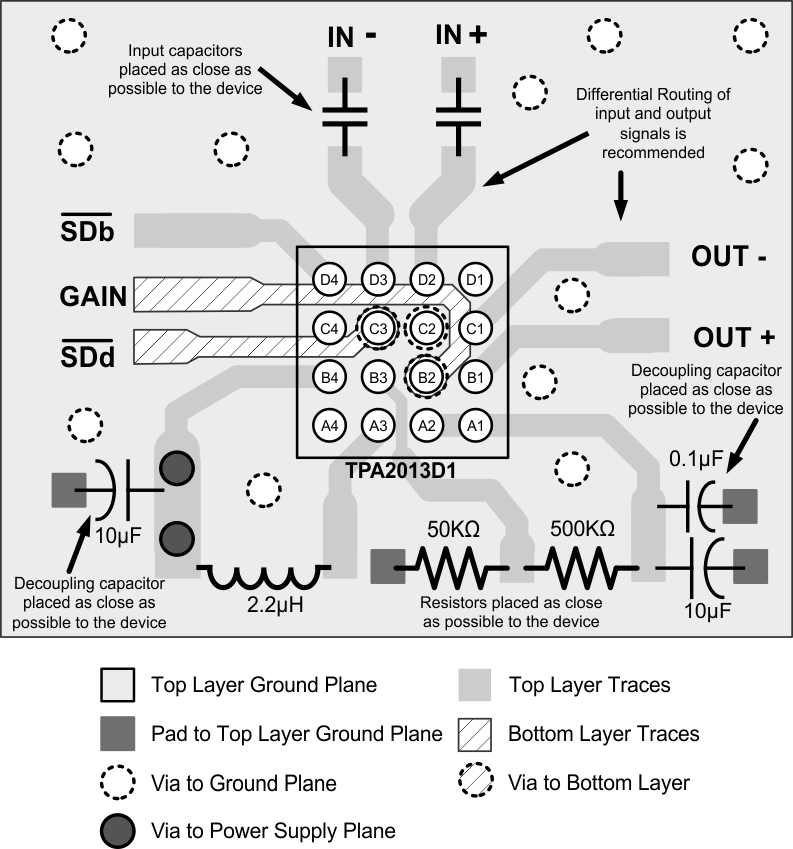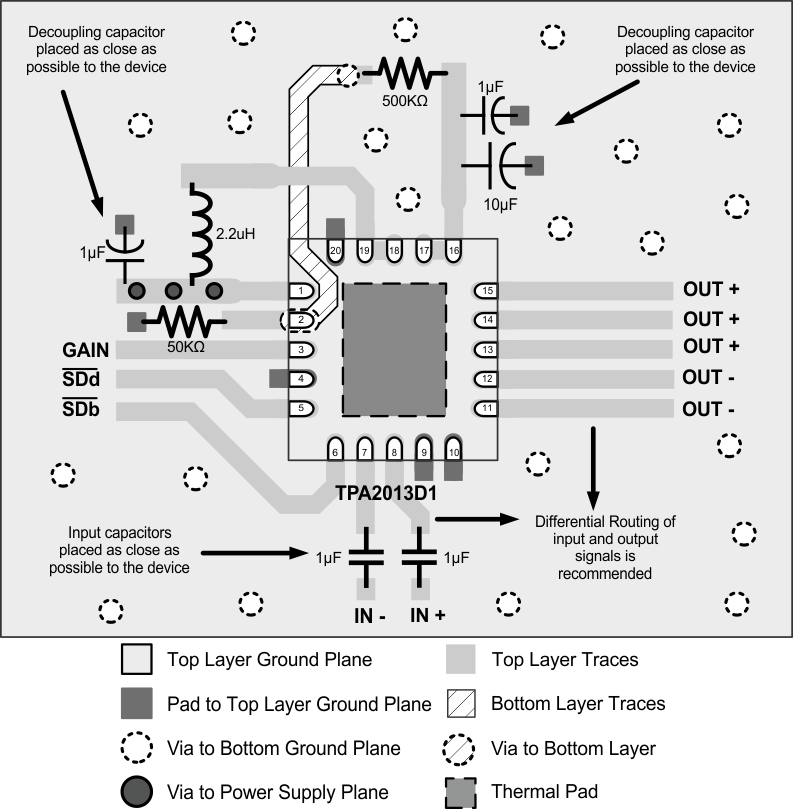SLOS520A August 2007 – March 2016 TPA2013D1
PRODUCTION DATA.
- 1 Features
- 2 Applications
- 3 Description
- 4 Revision History
- 5 Device Comparison Table
- 6 Pin Configuration and Functions
-
7 Specifications
- 7.1 Absolute Maximum Ratings
- 7.2 ESD Ratings
- 7.3 Recommended Operating Conditions
- 7.4 Thermal Information
- 7.5 DC Characteristics
- 7.6 Boost Converter DC Characteristics
- 7.7 Class D Amplifier DC Characteristics
- 7.8 AC Characteristics
- 7.9 Class D Amplifier AC Characteristics
- 7.10 Dissipation Ratings
- 7.11 Typical Characteristics
- 8 Parameter Measurement Information
- 9 Detailed Description
-
10Application and Implementation
- 10.1 Application Information
- 10.2
Typical Applications
- 10.2.1
TPA2013D1 With Differential Input Signal
- 10.2.1.1 Design Requirements
- 10.2.1.2 Detailed Design Procedure
- 10.2.1.3 Application Curves
- 10.2.2 Bypassing the Boost Converter
- 10.2.3 Stereo Operation Application
- 10.2.4 LED Driver for Digital Still Cameras
- 10.2.5 Design Requirements
- 10.2.6 Detailed Design Procedure
- 10.2.7 Application Curves
- 10.2.1
TPA2013D1 With Differential Input Signal
- 11Power Supply Recommendations
- 12Layout
- 13Device and Documentation Support
- 14Mechanical, Packaging, and Orderable Information
封装选项
机械数据 (封装 | 引脚)
散热焊盘机械数据 (封装 | 引脚)
- RGP|20
订购信息
12 Layout
12.1 Layout Guidelines
12.1.1 Component Placement
Place all the external components close to the TPA2013D1 device. Placing the decoupling capacitors as close to the device as possible is important for the efficiency of the class-D amplifier. Any resistance or inductance in the trace between the device and the capacitor can cause a loss in efficiency
12.1.1.1 Trace Width
Recommended trace width at the solder balls is 75 μm to 100 μm to prevent solder wicking onto wider PCB traces.
For high current pins (SW, PGND, VOUT+, VOUT–, VCCIN, and VCCOUT) of the TPA2013D1, use 100-μm trace widths at the solder balls and at least 500-μm PCB traces to ensure proper performance and output power for the device.
For low current pins (IN–, IN+, SDd, SDb, GAIN, VCCFB, VDD) of the TPA2013D1, use 75-μm to 100-μm trace widths at the solder balls. Run IN– and IN+ traces side-by-side to maximize common-mode noise cancellation.
12.1.2 Pad Side
In making the pad size for the WCSP balls, use nonsolder mask defined (NSMD) land. With this method, the solder mask opening is made larger than the desired land area, and the opening size is defined by the copper pad width. Figure 37 and Table 9 show the appropriate diameters for a WCSP layout.
 Figure 37. Land Pattern Dimensions
Figure 37. Land Pattern Dimensions
Table 9. Land Pattern Dimensions
| SOLDER PAD DEFINITIONS |
COPPER PAD | SOLDER MASK OPENING |
COPPER THICKNESS |
STENCIL OPENING |
STENCIL THICKNESS |
|---|---|---|---|---|---|
| Nonsolder mask defined (NSMD) |
275 μm (+0.0, –25 μm) |
375 μm (+0.0, –25 μm) |
1 oz max (32 μm) | 275 μm x 275 μm Sq. (rounded corners) |
125 μm thick |
NOTES:
- Circuit traces from NSMD defined PWB lands should be 75 μm to 100 μm wide in the exposed area inside the solder mask opening. Wider trace widths reduce device stand off and impact reliability.
- Recommend solder paste is Type 3 or Type 4.
- Best reliability results are achieved when the PWB laminate glass transition temperature is above the operating the range of the intended application.
- For a PWB using a Ni/Au surface finish, the gold thickness should be less 0.5 mm to avoid a reduction in thermal fatigue performance.
- Solder mask thickness should be less than 20 μm on top of the copper circuit pattern.
- Best solder stencil performance is achieved using laser cut stencils with electro polishing. Use of chemically etched stencils results in inferior solder paste volume control.
- Trace routing away from WCSP device should be balanced in X and Y directions to avoid unintentional component movement due to solder wetting forces.
12.2 Layout Examples
 Figure 38. TPA2015BGA Layout
Figure 38. TPA2015BGA Layout
 Figure 39. TPA2015QFN Layout
Figure 39. TPA2015QFN Layout
12.3 Efficiency and Thermal Considerations
The maximum ambient temperature depends on the heat-sinking ability of the PCB system. The derating factors for the YZH and RGP packages are shown in Dissipation Ratings. Apply the same principles to both packages. Using the YZH package, and converting this to θJA:

Given θJA of 80.64°C/W, the maximum allowable junction temperature of 150°C, and the maximum internal dissipation of 0.317 W (VDD = 3.6 V, PO = 1.7 W), the maximum ambient temperature is calculated with Equation 9:

Equation 9 shows that the calculated maximum ambient temperature is 124°C at maximum power dissipation under the above conditions. The TPA2013D1 is designed with thermal protection that turns the device off when the junction temperature surpasses 150°C to prevent damage to the IC. Also, using speakers more resistive than 4-Ω dramatically increases the thermal performance by reducing the output current and increasing the efficiency of the amplifier.